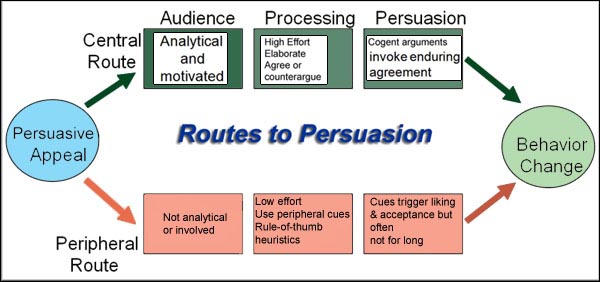Good evening Psych Era. How are you guys doing today? Good? That’s great! I can not believe we have been here for so many months. It feels like just yesterday; I made my first post here. As I continued to go on, I thought I would lose things to talk about; however, that has not been the case due to the nature of psychology. Everything we do correlates to a psychological subject. Whether it be going through heartbreak, feeling attraction towards someone, or sitting down to play video games, everything we do is connected. Anyways, let us get to the topic of today, persuasion. Humans are creatures of curiosity. Anytime we see something new, we feel almost inclined to know about it. We also do not see our own convictions as mere opinions; therefore, if people have different views from us, we tend to try and “convince them” in a sense. This is where the Elaboration Likelihood Model (ELM) originates from. It is essentially the strength of an argument and how much one needs to do in order to change another person’s mind about something. Some people are extremely to deal with due to the phenomenon of belief perseverance; however, those who are more reasonable can be convinced through two routes: the peripheral and central routes of persuasion.

This topic is very simple to comprehend and will save you so much money in the future from scammers- I mean advertisements. Now, let us get into it. First, let us start with the peripheral route of persuasion. It is essentially the persuasion of a person through cues. It is the lazy, heuristic-filled way of thinking. This way of persuasion barely changes a person’s attitude because they are not motivated or analytical. Let me simplify this process a little bit. In this instance, let us say there is a commercial about a new phone, and a celebrity is using it. Because of this, people feel almost inclined to get the phone without thinking about whether it is eco-friendly, whether they really want it, etc. Essentially, peripheral thinking does not really help people gain any type of change in behavior(it is extremely temporary) on to the following, more effective route- central persuasion. This persuasion is more careful, motivated, and analytical. This involves an algorithm and open-mindedness. In this case, people look at the facts rather than just jumping to conclusions. For instance, let’s say you are trying to buy a car, and the car seller is trying to convince you to buy it. They will emphasize the car’s safety features, how good it is for the economy, etc.
:max_bytes(150000):strip_icc()/what-is-a-heuristic-2795235-f697ce899b874cc592476101acbd537b.png)
The main point I want to emphasize is how important it is how to avoid false advertising. When watching an ad or anything, think about if it is useful for you, and do not be influenced by the fact Chris Pratt is selling a boat. Psych Era, I am trying to save you from the pandemic of outrageous spending because of dumb ads. The more you know, the more you can avoid it. Thank you, see you next time on The Psych Era.
I really liked how you broke down how persuasion works. I took a one semester psychology class in high school but this is really cool since you are applying what we do (associating brands with people, etc.) to how our brain works. I also thought the first graphic was cool since it explained in a visual format what you were going at. Keep up the great work!
I will admit that I have been the victim of buying something because someone famous promotes it. Sometimes I can be an impulsive spender, so these kind of commercials are dangerous to me. But I really like how we can connect every day things back to psychology. This is why I am majoring in it, because it is such a universal topic that most people can relate to in some type of way.